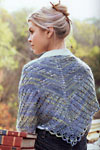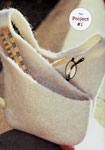Book Review: The Knitter’s Book of Yarn
November 24th, 2007 | View Comments
Author: Clara Parkes
Publisher: Potter Craft
Rating: 
Buy The Knitter’s Book of Yarn on Amazon.com
Happy Thanksgiving and Black Friday to my US readers!
Potter Craft was also kind enough to send me a copy of Clara Parkes’s new book, The Knitter’s Book of Yarn. I have a healthy appreciation for all things Clara, having been a member of Knitter’s Review almost since the day I learned to knit. But I think I might have passed this one by if I were just browsing in a bookstore or a local yarn shop.
And that would have been a dreadful, dreadful mistake. I’ve read the entire thing cover to cover and I really think that every serious knitter needs to own a copy of this book.
Of all the projects that I’ve been slightly disappointed with, most of them have been due to Yarn Mistakes. Choosing a loosely-spun wool for a blanket, leading to massive pilling over everything. Choosing yarns with a high percentage of acrylic for projects that require aggressive blocking. This book will help you stop making Yarn Mistakes.
The book is divided into three detail-packed sections about how yarn is made and how this will affect your finished product. Clara manages to present a lot of technical information about fiber and fabric in a colloquial and easy-to-read style.
The first section goes over the major fiber groups: protein, cellulose, cellulosic, and synthetic, with subsections for each fiber type. Each subsection describes where the fiber type comes from, and describes a number of different properties of the fiber that affect the yarn, including different quality grades, how it behaves in blends, and how it behaves on the needles. The pages on alpaca from this section are excerpted in the Winter 2007 Interweave Knits.
The second section describes how yarn is made and how to evaluate a finished yarn. Clara takes you through a tour of farms and fiber festivals, discusses organic yarns and the different methods of spinning yarn, and the hows and whys of pills. This section was extraordinarily helpful for someone like me who does not spin and mostly just marvels that yarn manages to show up on a yarn store shelf all skeined and pretty-like.
And finally, the third section is on plying and other ways of assembling a knit-able yarn. Again, this section was an amazing trove of information for a non-spinner, especially everything about how different fibers behave with different amounts of twist and with different numbers of plies, and how this translates into loft and wearability.
As if this wealth of knowledge wasn’t reason enough to run out and buy this book, there are patterns too! The forty patterns are distributed throughout the third section of this book, with each pattern highlighting a particular method of yarn construction. A wide variety of projects and skill levels are represented, from basic wool mittens to cabled cardigans to lace shawls.
Pick of the Projects:
 Diamonds and Pearls Shawl. This project is from the section on textured yarns and features Artyarns Silk Rhapsody—a yarn with one ply of silk and a second ply of brushed mohair. The lace pattern is attractive but not particularly complicated, and the light variegation of the yarn adds a nice touch. A word of warning: The entire lace pattern is written out. Although there are charts for other patterns, there is none for this one.
Diamonds and Pearls Shawl. This project is from the section on textured yarns and features Artyarns Silk Rhapsody—a yarn with one ply of silk and a second ply of brushed mohair. The lace pattern is attractive but not particularly complicated, and the light variegation of the yarn adds a nice touch. A word of warning: The entire lace pattern is written out. Although there are charts for other patterns, there is none for this one.
 Norwegian Snail Mittens. These Scandinavian-inspired mittens are from the section on four-ply yarns and use Dalegarn Baby Ull. The palm side is worked in simple vertical stripes while the back of the mitten features a couple of adorable snails and a scroll motif.
Norwegian Snail Mittens. These Scandinavian-inspired mittens are from the section on four-ply yarns and use Dalegarn Baby Ull. The palm side is worked in simple vertical stripes while the back of the mitten features a couple of adorable snails and a scroll motif.
 Calla Lily Bag. This stunning medium-sized bag with three compartments is from the section on felt. The yarn is Fleece Artist Kid Aran and the design is the brainchild of Cat Bordhi. The pattern includes miniature pattern pieces so you can build a model to help you understand how the bag’s unique shape is constructed.
Calla Lily Bag. This stunning medium-sized bag with three compartments is from the section on felt. The yarn is Fleece Artist Kid Aran and the design is the brainchild of Cat Bordhi. The pattern includes miniature pattern pieces so you can build a model to help you understand how the bag’s unique shape is constructed.
The Knitter’s Book of Yarn wraps up with a short section on the “care and feeding” of different fibers and yarns and an explanation of different weights and the Standard Yarn Weight System of the Craft Yarn Council of America. A glossary of terms, techniques, and abbreviations, a list of yarn resources, recommended reading, and designer biographies round out this impressive yarn reference.
Buy The Knitter’s Book of Yarn on Amazon.com
CogKnition posted this on November 24th, 2007 @ 1:34am in Book Reviews | Permalink to "The Knitter’s Book of Yarn"









I bought the book just the other day because I had a coupon. Once I started reading it, I couldn’t put it down. Great review!
fantastic review – i was gifted the book, and it is a must have, you are right, and the CB felted bag – I’m not usually into felting – but that is on my to do list.